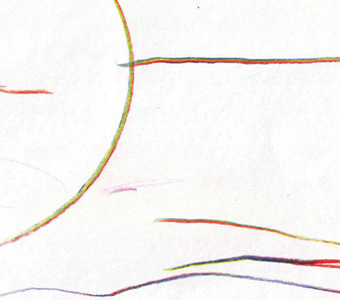 If Keith Rowe and Graham Lambkin haven't produced one of the most mind-bending records of 2013, they're at least high in the running. Making A shares its name with one of Cornelius Cardew's Schooltime Compositions. Written in 1967, these pieces were designed to help musicians and non-musicians develop their own methods of interpretation and music-making. They emphasize process over finished products and personal development over pretty results. Rowe and Lambkin's unusual recording emphasizes process too, but turns the spotlight on the listener. The album changes color and shape with the light. Sometimes improvised, sometimes structured; it constantly reflects its audience and hides its perpetrators. Few other records like it come to mind.
If Keith Rowe and Graham Lambkin haven't produced one of the most mind-bending records of 2013, they're at least high in the running. Making A shares its name with one of Cornelius Cardew's Schooltime Compositions. Written in 1967, these pieces were designed to help musicians and non-musicians develop their own methods of interpretation and music-making. They emphasize process over finished products and personal development over pretty results. Rowe and Lambkin's unusual recording emphasizes process too, but turns the spotlight on the listener. The album changes color and shape with the light. Sometimes improvised, sometimes structured; it constantly reflects its audience and hides its perpetrators. Few other records like it come to mind.
For over forty years, on nearly every recording and at nearly every concert, Keith Rowe has played a guitar of some kind. He has spent much of his life wrestling with the instrument, pulling it apart, recreating it, and developing a personal technique for playing it, which he compares to painting. But on Making A the guitar is gone. Rowe is credited only with "contact mic/objects/field recordings"; Lambkin with "contact mic/objects/room." A more comprehensive list for both artists would include tape dispenser, paper, pencil, scissors, water faucet, plastic, and perhaps a few other common materials and utensils.
A good deal of the record consists of Keith and Graham using these objects to draw, color, or to otherwise undertake seemingly non-musical actions. They amplify the sound of crumpled paper and the stroke of a pencil, combine those with the sound of traffic outside a window, then cut to an extreme close-up of rippling adhesive and intense noise: a car engine, the sound of gas igniting on a stove, the roar of a train speeding through New York toward Poughkeepsie. Sounds repeat themselves, others distort and fizzle out, still others reappear at different volumes with different effects applied.
Acousmatic confusion abounds, but not just with regard to the sounds. A semblance of Rowe's gestural guitaring survives this guitar-less performance, but distinguishing his contributions from Graham's borders on the impossible. Few personal identifiers survive their time-bending, space-expanding edits. That's why Rowe ditching the guitar is significant, and why the connection to Cardew's "Making A" matters.
In a 2009 interview with Jon Eyles of All About Jazz, Keith is asked if he can look five years into the future and describe where he might be musically. Rowe replies: "Obviously no, but I have a kind of sense of wanting to have a kind of performance that is based on the live experience of being. I think too many performances are actually a bit like the live performance of the CD… I think I would like what I do to be the trace of a process. It is just there in that unique moment of looking, in the opportunity to see it, and then it is gone and you can never see it again."
In the absence of melody and a solid rhythm, without clear structural markers, on a record that barely even demands its audience's attention, the musicians all but disappear, along with the music. The thought of instruments goes out the window. We're left with the fading image of two men travelling, drawing, cutting, maybe pouring a drink of water. No message comes through these events; just a sense of place, the passing of time, and movement. A trace. Making A does for its audience what Cardew's Schooltime Compositions are meant to do for the performers: give them a chance to react and interpret on their own terms.
With so little in the way, thinking creatively about the music is that much easier. What does the "A" in Making A stand for? Couldn't anyone with some pots and pans make this music too? What are the musicians trying to say by making noise like this? Is it even music? Cardew can't tell you that; neither can Keith Rowe, nor Graham Lambkin. And neither can I.
samples:
 
Read More

